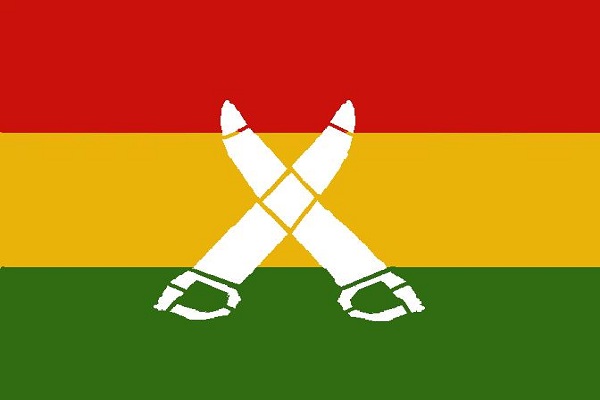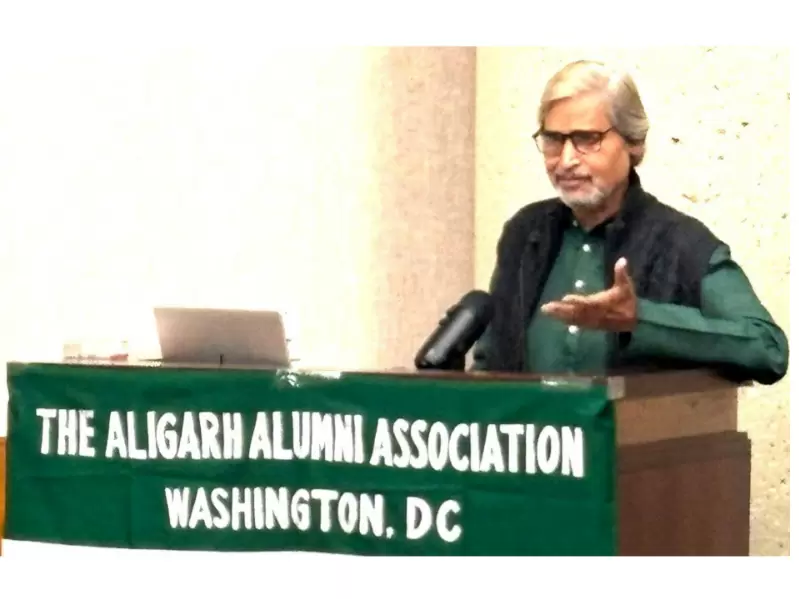ओरेगॉन से पंजाब तक : देसी अप्रवासियों ने भारतीय स्वतंत्रता संग्राम को कैसे दी चिंगारी
गदर पार्टी की औपचारिक स्थापना 15 जुलाई, 1913 को एस्टोरिया, ओरेगॉन, अमेरिका में हुई थी। लेकिन इस अभूतपूर्व आंदोलन की नींव वर्षों पहले विदेशों में रहने वाले भारतीय बुद्धिजीवियों और कार्यकर्ताओं द्वारा रखी गई थी। वर्ष 1884 में दिल्ली में जन्मे एक प्रमुख व्यक्ति लाला हर दयाल इस आंदोलन के वैचारिक नेता के रूप में उभरे।
 भारत में आजादी का आंदोलन करने वाली यानी पार्टी गदर का निशान। / Wikipedia Commons
भारत में आजादी का आंदोलन करने वाली यानी पार्टी गदर का निशान। / Wikipedia Commons
स्वतंत्रता की मांग न केवल भारतीय उपमहाद्वीप के स्वतंत्रता सेनानियों द्वारा की गई थी बल्कि यह अन्य लोगों की भी प्रबल आकांक्षा थी। इस आकांक्षा ने घर से दूर रहने वाले भारतीयों के दिलों में एक जुनून जगाया जिससे भौगोलिक रूप से दूर होने के बावजूद भारतीयों का अपनी मातृभूमि के प्रति एक अटूट जुड़ाव पैदा हुआ। इसके वास्ते प्रमुख विद्रोहों में सबसे अहम था गदर आंदोलन। इस आंदोलन को भारत में अंग्रेजों को सत्ता से हटाने के उद्देश्य से मुख्य रूप से पंजाब से आए भारतीय प्रवासियों द्वारा शुरू किया गया था।
कैसे अस्तित्व में आई गदर पार्टी
गदर पार्टी की औपचारिक स्थापना 15 जुलाई, 1913 को एस्टोरिया, ओरेगॉन, अमेरिका में हुई थी। लेकिन इस अभूतपूर्व आंदोलन की नींव वर्षों पहले विदेशों में रहने वाले भारतीय बुद्धिजीवियों और कार्यकर्ताओं द्वारा रखी गई थी। वर्ष 1884 में दिल्ली में जन्मे एक प्रमुख व्यक्ति लाला हर दयाल इस आंदोलन के वैचारिक नेता के रूप में उभरे।
उन्होंने संत बाबा वसाखा सिंह ददेहर, बाबा ज्वाला सिंह और सोहन सिंह भकना जैसे अन्य नेताओं के साथ पेसिफिक कोस्ट हिंदुस्तान एसोसिएशन के बैनर तले संयुक्त राज्य अमेरिका, कनाडा, पूर्वी अफ्रीका और एशिया में प्रवासी पंजाबियों को एकत्र। इसी समूह ने बाद में गदर पार्टी का रूप ले लिया।
पार्टी का नेतृत्व पंजाबियों का एक विविध गठबंधन था जिसमें हिंदू, सिख और मुस्लिम शामिल थे। ये सब भारत में ब्रिटिश शासन को समाप्त करने के एक समान उद्देश्य से एकजुट थे। उनके समाचार पत्र, द ग़दर के मुखपृष्ठ पर 'राम, अल्लाह और नानक' नाम अंकित था। यह इस क्रांतिकारी उद्देश्य में विभिन्न धार्मिक समुदायों की एकता का प्रतीक था।
आंदोलन की प्रेरणा: उपनिवेशवाद और भेदभाव-विरोधी
उत्तरी अमेरिका में भारतीयों द्वारा सही गई उपनिवेशवादी भावनाएं और नस्लीय पूर्वाग्रह दोनों ने ग़दर आंदोलन के लिए ईंधन का काम किया। इस अवधि के दौरान भारतीय प्रवासियों, मुख्य रूप से पंजाब से, को संयुक्त राज्य अमेरिका और कनाडा में गंभीर नस्लीय पूर्वाग्रह का सामना करना पड़ा। इस भेदभाव ने अमेरिकी लोकतांत्रिक आदर्शों के संपर्क के साथ उन्हें भारतीय स्वतंत्रता के उद्देश्य का समर्थन करने के लिए प्रेरित किया।
1914 में कोमागाटा मारू घटना वह निर्णायक क्षण था जिसने इस आंदोलन को गति दी। लगभग 300 पंजाबी यात्रियों को ले जाने वाले जापानी जहाज को भेदभावपूर्ण आव्रजन कानूनों के कारण कनाडा में प्रवेश से वंचित कर दिया गया था। जहाज को भारत लौटने के लिए मजबूर किया गया और उसके कई यात्रियों को गिरफ्तार कर लिया गया। इस घटना ने नस्लीय अन्याय के अन्य रूपों के साथ मिलकर भारत में ब्रिटिश शासन के खिलाफ लड़ने के लिए भारतीय प्रवासियों के संकल्प को मजबूत किया।
क्रांतिकारी गतिविधियां और असफलताएं
प्रकृति में क्रांतिकारी ग़दर पार्टी ने भारत में सशस्त्र विद्रोह को प्रेरित करने की कोशिश की। पार्टी के सदस्य, जो ज्यादातर विदेश में रहने वाले पंजाबी थे, ने बैठकें कीं, पत्रक छपवाए और क्रांतिकारी कारणों के लिए दान मांगा। पार्टी के समाचार पत्र, द ग़दर ने खुद को 'ब्रिटिश शासन का दुश्मन' घोषित किया और बहादुर सैनिकों से भारत की आजादी की लड़ाई में शामिल होने का आह्वान किया।
1914 में प्रथम विश्व युद्ध शुरू होने के साथ गदर पार्टी को अंग्रेजों के खिलाफ हमला करने का अवसर मिला। समूह के सदस्य गदर विद्रोह यानी एक सशस्त्र विद्रोह की योजना बनाने के लिए भारत वापस चले गए। उनका लक्ष्य ब्रिटिश सेना में सेवारत भारतीय सैनिकों के बीच विद्रोह भड़काना था।
हालांकि अंग्रेजों द्वारा विद्रोह को कठोरता से दबा दिया गया। इसके परिणामस्वरूप लाहौर षड्यंत्र केस के मुकदमे के बाद 42 विद्रोहियों को फांसी दे दी गई। इस झटके के बावजूद गदर पार्टी ने जर्मनी और ऑटोमन साम्राज्य के समर्थन से 1914 से 1917 तक अपनी क्रांतिकारी गतिविधियां जारी रखीं।
गदर आंदोलन पर ब्रिटिश सरकार की प्रतिक्रिया गंभीर थी। 1917-18 में सैन फ्रांसिस्को में 'हिंदू षड्यंत्र' परीक्षण ने आंदोलन के इतिहास में एक महत्वपूर्ण क्षण चिह्नित किया। इस मुकदमे को अमेरिकी प्रेस में सनसनीखेज कवरेज मिली, जिससे भारतीय अप्रवासियों के प्रति संदेह और शत्रुता बढ़ गई। मगर इन चुनौतियों के बावजूद गदर पार्टी 1920 के दशक में पुनर्गठित हुई और 1947 में भारत की आजादी तक पंजाबी और सिख पहचान के केंद्र बिंदु के रूप में काम करती रही।
इस बार भारत के स्वतंत्रता दिवस पर हमें ग़दर पार्टी और उन भारतीय प्रवासियों को नहीं भूलना चाहिए जिन्होंने अपनी मातृभूमि के स्वतंत्रता आंदोलन में महत्वपूर्ण भूमिका निभाई थी। उनकी निस्वार्थता और उद्देश्य के प्रति प्रतिबद्धता इस बात की गंभीर याद दिलाती है कि भारतीय स्वतंत्रता आंदोलन कितना आपस में जुड़ा हुआ था और यह कैसे दुनिया भर से भारतीयों को एक साथ लेकर आया।
ADVERTISEMENT
ADVERTISEMENT
E Paper
Video



 मालविका चौधरी
मालविका चौधरी










.jpg)

Comments
Start the conversation
Become a member of New India Abroad to start commenting.
Sign Up Now
Already have an account? Login